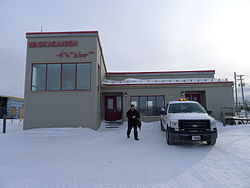Waskaganish
ᐙᔅᑳᐦᐄᑲᓂᔥ (Cree) | |
|---|---|
Cree community | |
 | |
| Etymology: Little House | |
| Coordinates: 51°29′N 078°45′W / 51.483°N 78.750°W[1] | |
| Country | Canada |
| Province | Quebec |
| Region | Northern Quebec |
| TE | Eeyou Istchee |
| Formed | 1978 |
| Government | |
| • Type | Cree reserved land |
| • Federal riding | Abitibi—Baie-James—Nunavik—Eeyou |
| • Provincial riding | Ungava |
| • Chief | Clark Shecapio |
| Area | |
| • Land | 496.99 km2 (191.89 sq mi) |
| Population (2021)[2] | |
| • Total | 2,536 |
| • Density | 5.1/km2 (13/sq mi) |
| Time zone | UTC−05:00 (EST) |
| • Summer (DST) | UTC−04:00 (EDT) |
| Postal Code | |
| Area code | 819 |
| Website | www |
Waskaganish (Cree: ᐙᔅᑳᐦᐄᑲᓂᔥ/wâskâhîkaniš, Little House; French pronunciation: [waskaɡaniʃ]) is a Cree community of over 2,500 people at the mouth of the Rupert River on the south-east shore of James Bay in Northern Quebec, Canada. Waskaganish is part of the territory referred to as "Eeyou Istchee" ("The Land of the People" in Cree) encompassing the traditional territories of Cree people in the James Bay regions of what is now Northern Quebec and Ontario.
The community of Waskaganish celebrated its 350-year anniversary in 2018. The village is located at the site of the former Fort Rupert, the first Hudson's Bay Company trading post on Hudson Bay.
